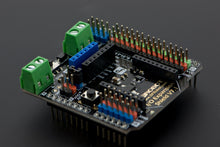
- Compatible with the new Arduino Due
- 3.3V/5V operating voltage select
- Switch for wireless communication & programme
- More easily recognitive interfaces
- Colorful header for illustrating digital or analog pins
- Immersion gold surface
IO Expansion shield is one of the market favourites. Fast robotics prototyping made affordable and simple thanks to this design. Soldering and wiring often become a problem when a bridged connection happens and components break. Increasing time and cost for projects. Often, without this solution and a soldering station, wire crimping tools or soldering station, robot prototyping or electronics DIY becomes a very long term project.
Gravity IO Expansion Shield for Arduino Selection Guide
The DFRobot Expansion shield introduced to the market the famous color code for sensors and actuators' input and output. The 3 pin format for Signal, Voltage, and Ground is extremely useful, especially if used altogether with our increasingly large range of modules, sensors, and devices that just fit.
Alternatively, the board includes power input for salvaged power supplies or laboratory power supplies. Very common Xbee socket for multipurpose wireless connectivity such as RF, wireless, Bluetooth.
The new version includes a voltage hardware setting through a jumper to allow compatibility with a bigger range of components at 3.3v like Raspberry pi, Due, and others.
It also includes a Servo external power, with a protective diode. This way you can enable a large range of servos from your Arduino.
The latest version features a convenient switch that lets you program your ATmega328 boards like UNO, while you have another Serial device connected like an Xbee. Switch it, program it, and get it back up and running with another switch. You don't need to disassemble your hardware or wiring.
Gravity: IO Expansion Shield for Arduino Sensor Connection
A LED on top board and a reset button is in order to make it just a natural extension to Arduino boards. The LED is connected to pin 13.
Specifications:
Input Voltage: 7-12V, PWR_IN
Input Voltage: 4.8-6V, SERVO_PWR, depending on your servo
Compatible module voltage: 5V/3.3V
Support interface: I2C, SPI, Xbee (Xbee pro), Bluetooth, APC220









